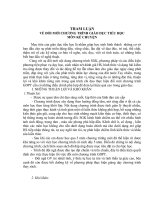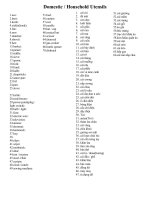Tutorial 1(SOLUTION) GROSS DOMESTIC PRODUCT (GDP)
Bạn đang xem bản rút gọn của tài liệu. Xem và tải ngay bản đầy đủ của tài liệu tại đây (439.9 KB, 7 trang )
ECON7001Tutorial 1
Gross Domestic Product
Chapter 4
Question 1
“Is China about to overtake US as the world's largest economy?”
-
BBC 30 April 2014
-
/>
(a) By what economic measure is this claim being made?
(b) What problems arise when making international comparisons of economic activity?
(c) Does this mean China is wealthier than the United States?
Solutions
(a) Comment on the “size” of an economy is normally a reference to its gross domestic
product (GDP). Note this is total economic value added, NOT per capita. Note that it
ignores informal economy. Also note that construction of GDP measure (what is in
and out, eg. illicit drugs and prostitution) is different across countries. And that
goods are heterogenous, so different production and consumption profiles lead to
different totals due to aggregation assumptions (industry deflators etc)
What is GNP and how does that differ?
GDP measures the market value of all final goods and services produced in a
particular place over a particular time (normally a year). GDP is also a measure of the
total spending by consumers, businesses, government and foreigners on
domestically produced goods and services. Because every dollar that is spent
becomes somebody else’s income GDP is also a measure of income earned from the
production of domestically produced goods and services.
(b) Since GDP is measured by each country’s currency, international comparison
requires the usage of either exchange rate or PPP. Using purchasing power parity
(PPP) requires additional knowledge of comparable baskets of goods - which PPP?
On the flip side, using current exchange rates is problematic because of FX
fluctuations that are fairly meaningless to aggregate production levels in the short
run.
-
Two countries with different levels of development cannot be compared on the basis
of GDP, as GDP will not include the same activities in the two countries (part of
economic activity will be excluded from the comparison);
-
Also, statistical methods used to measure outputs and prices differ significantly across
the world
(c) Not really. Even though total Chinese production, spending and income are worth
about the same total as the US, that figure is shared amongst many more people in
China (1.35billion) compared to the US (319million). To make wealth, or standard of
living comparisons it is appropriate to divide total GDP by population (a per capita
GDP). Hence, the average Chinese person is only 25% as wealthy as the average US.
- Distribution of wealth also matters to what we could consider economic success of
raising living standard widely, and much controversy has occurred due to the
ongoing concentration of wealth in many countries into the hands of the top 1%.
Question 2
An Australian wool farmer sold some wool to a local textile mill for $5. The textile mill spun
it into yarn and sold it to Grandma Jones for $8. Grandma Jones runs a stall at the
Southbank Markets where she knits the yarn into a custom tea cosy and sells it for $10.
a) How much was contributed to Australia’s GDP. How much value was added at each
step?
b) How does your answer change if Grandma Jones is your Grandma and rather than
selling the tea cosy, she gives it to you for your birthday?
c) How does your answer change if the textile mill is owned by a Chinese company?
d) How does your answer change if the textile mill is located in China?
Solutions
a) GDP measures the value of all final goods and services. Because the wool and the
yarn are each steps in the chain to making the final tea cosy (that is, they are
intermediate goods) it would be double-counting if they were added to GDP. So $10
is added to GDP.
The value added at each stage can be calculated by taking what the good was sold
for and deducting what was paid for the raw materials.
o The wool farmer started with nothing (presumably they bred and raised the
sheep) then sold the wool for $5, so we conclude that they added $5 of
value.
o The textile mill bought $5 of wool and sold it as yarn for $8 so they added $3
of value (8 – 5).
o Finally Grandma Jones bought the wool for $8 and sold the final product for
$10 so she added $2 of value (10 – 8).
It should be noted that the value-added at each step (5 + 3 + 2) sums to the final
value (10).
b) Gifts, domestic work as well as illegal and unreported production are neither
measured nor reported in most estimates of GDP. So, the “final” good becomes the
yarn that was sold to Grandma for $8.
c) Foreign ownership of the factory doesn’t change GDP. Remember that GDP
measures everything produced in some place, so the owner of the mill is irrelevant
(this effect is accounted for in a different figure called Gross National Product).
d) The “domestic” in gross domestic product means that we are only trying to account
production that occurred within a particular place (in this case Australia). To account
for this we can simply disregard the value added by the foreign textile mill. Value
added by the farmer is $5 and the value added by Grandma is $2, so domestic GDP is
now increased by $7.
Question 3
Consider the following production data for the made-up country of Kuznetsistan, which
produces only milk and juice.
2012
2013
Quantity
Price
Quantity
Price
Milk
10L
$2/L
8L
$4/L
Juice
5L
$1/L
9L
$2/L
a) Calculate nominal GDP for 2012 and 2013
b) Calculate the growth rate in nominal GDP between these years
c) What can be concluded about the economic growth rate from this figure?
d) Calculate real GDP for 2012 and 2013 using 2012 as the base year
e) Calculate the growth rate in real GDP between these years
f) What can be concluded from this figure?
g) Calculate the GDP deflator for 2012 and 2013. What does this number mean?
Solutions
a) Denoting nominal GDP as PY, prices as P and quantities as Q:
PY in 2012 = P milk in 2012 x Q milk in 2012 + P juice in 2012 x Q juice in 2012
PY in 2012 = 2 x 10 + 5 x 1
PY in 2012 = $25
PY in 2013 = P milk in 2013 x Q milk in 2013 + P juice in 2013 x Q juice in 2013
PY in 2013 = 4 x 8 + 9 x 2
PY in 2012 = $50
b) To calculate percentage growth, we take
(new – old)/old x 100$ = (50-25)/25 x 100% = 100%
c) Nothing. An increase in nominal GDP can be caused by an increase in prices or in
quantities (or a combination of both).
d) Real GDP (Y) is equal to nominal GDP in the base year, so
Y in 2012 = $25
Real GDP is equal to the quantities from the current year times the prices from the
base year, so
PY in 2013 = P milk in 2012 x Q milk in 2013 + P juice in 2012 x Q juice in 2013
PY in 2013 = 2 x 8 + 1 x 9
PY in 2013 = $25
e) It hasn’t changed, so it’s 0%
f) The total value of production in 2012 is the same as in 2013
g) By definition, the GDP deflator is
GDP deflator = (Nominal GDP/Real GDP) x 100
So in 2012
GDP deflator in 2012 = 25/25 x 100 = 100
and in 1013
GDP deflator = 50/25 x 100 = 200
You may have noticed that because nominal and real GDP are equal in the base year,
the GDP deflator will always be 100 in the base year. As such, we can interpret the
GDP deflator as a measure of the price level compared to the base year. Because the
GDP deflator was 200 in 2013 this means that prices in this year were double that of
2012.
Question 4
How would each of the following be recorded using the spending method of calculating
Australia’s GDP for this year?
a) Teddy’s Timber Inc. in Brisbane buys an Australian-made circular saw
b) Motoko from Mullumbimby buys an Australian-made circular saw
c) The department of Forestry buys an Australian-made circular saw
d) JokoKayu in Jakarta buys an Australian-made circular saw
e) Hamdi’s Hardware in Hobart manufactures a circular saw but does not sell it
f) Hamdi’s Hardware in Hobart sells a circular saw it produced last year to Motoko
from Mullumbimby
g) Clive Palmer buys shares of existing company Hancock Prospecting
h) Clive Palmer buys new shares in the new start-up company Digging Pty Ltd
i) Penny from Perth buys a TV from Erik Electrical who imported it from South Korea
Solutions
a) + Investment (capital formation)
b) + Consumption
c) + Government
d) + Net Exports
e) + Investment (inventory investment)
f) + Consumption, - Investment (inventory investment)
g) Nothing to record
h) Nothing to record (although when the Digging Pty Ltd spends this money on capital
goods it will be recorded as Investment (capital formation)
i) + Consumption, - Net Exports. The retail price of the TV will be recorded as
consumption while the import price of the TV will be recorded under imports. GDP
will change by the difference.
Question 5
Discussion: Who invented GDP? And why? What things can increase GDP and make welfare
go down?
Solutions
The idea of measuring the economy became politically important during the great
depression of the 1930s, triggered by a financial collapse in October 1929. Mass
unemployment and the inability to monitor macro economic conditions led to the formation
Bureau of Foreign and Domestic Commerce's Division of Economic Research, headed by
prominent economist Simon Kuznets, to develop a method of economic measurement of
the macro economy. The foundations for GDP measurement were published in eth 1937
report National Income, 1929–32.
That original report is available here
/>Even within GDP (or more precisely, the System of National Accounts) can be used to
generate other measures that also imply well-being – per capita incomes, wages, etc
/>It is also important to understand that the boundary of the formal economy has changed
radically over the century – child care, home services, financial services and so forth are
included, but may not be welfare enhancing if they.
But the usefulness is that in broad terms GDP correlates with many other physical measures
of well-being, though exactly what causes these is NOT the GDP, but usually specific factors
that greater economic activity makes relatively more affordable (public health etc).
There are activities/expenditures which are included in GDP calculation but does not
directly increase individuals’ welfare: government expenditure for example (government
service or military expenditure…). In addition, many destructive events or activities can
increase GDP while decreasing overall welfare. For example, a massive hailstorm that
creates demand for thousands of new roofs and windows in a particular region, for
example, is not an economically beneficial event. But it would have the effect of increasing
GDP, as millions would be spent on acquiring these goods and services. Another example,
divorce may causea large amount of emotional strife for those involved. A high divorce rate
is something almost no one considers beneficial. But divorce is expensive, and creates
thousands of jobs for lawyers, judges, and other legal mediators. If the divorce rate were to
increase by 10% one year, this would increase GDP.









